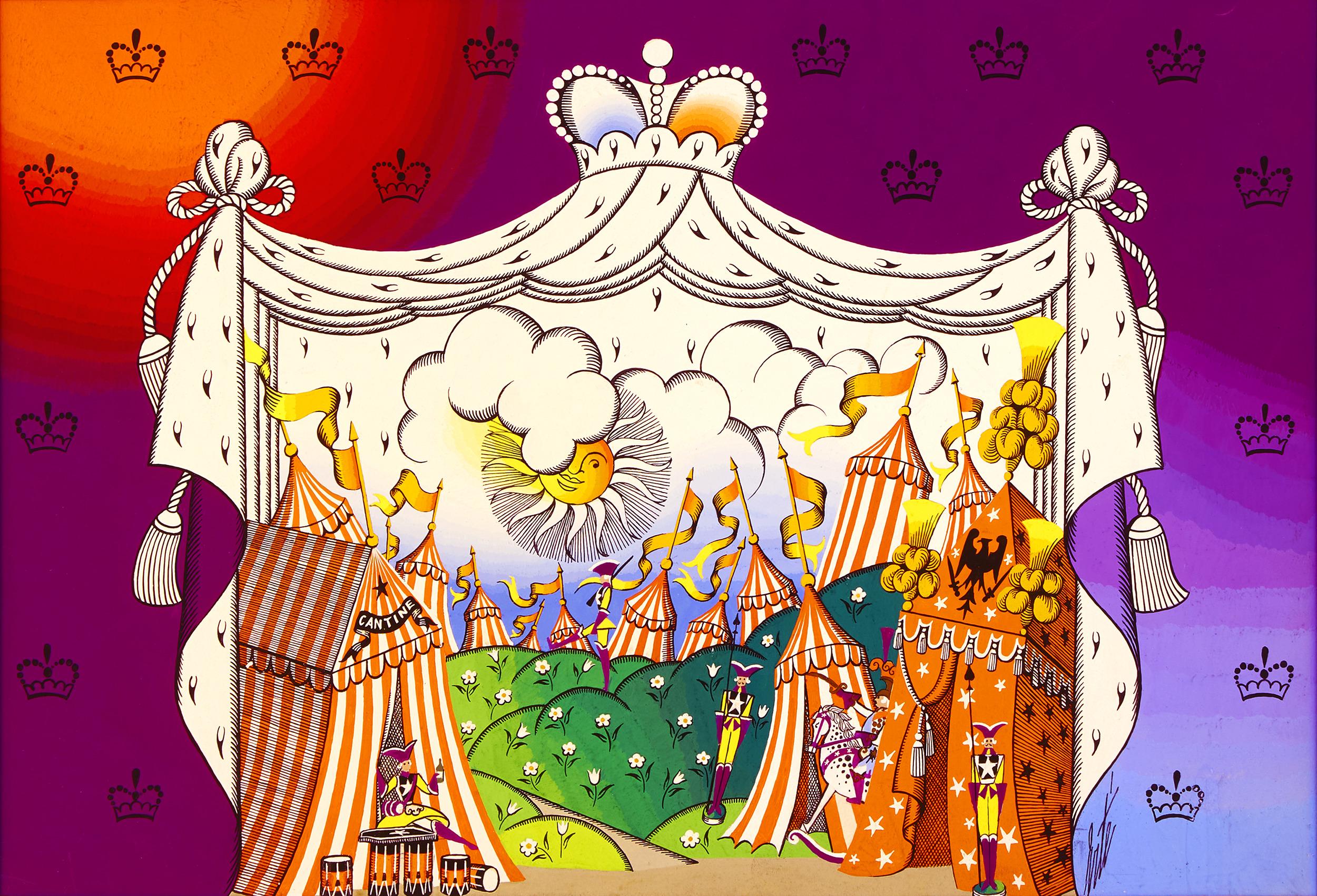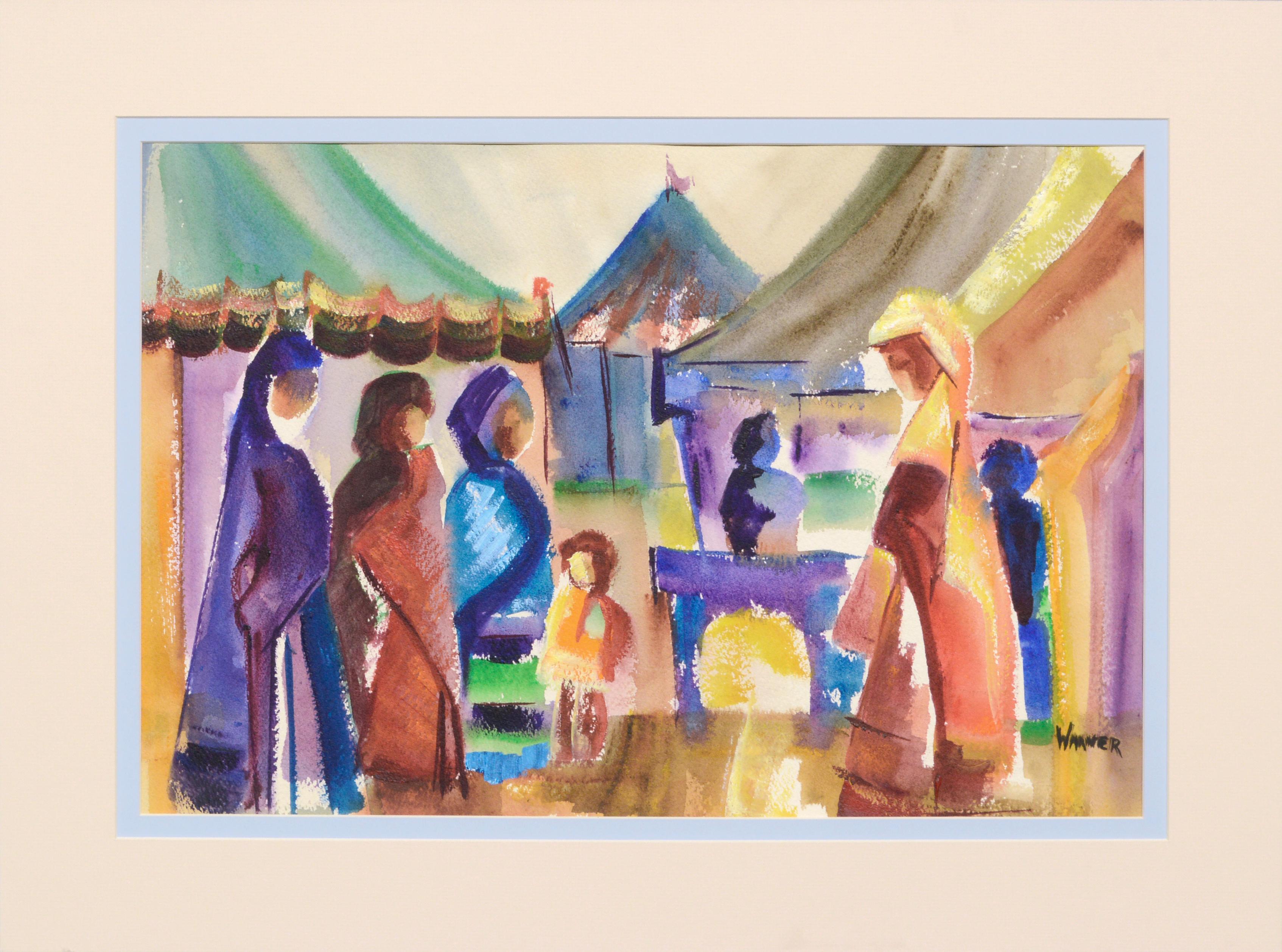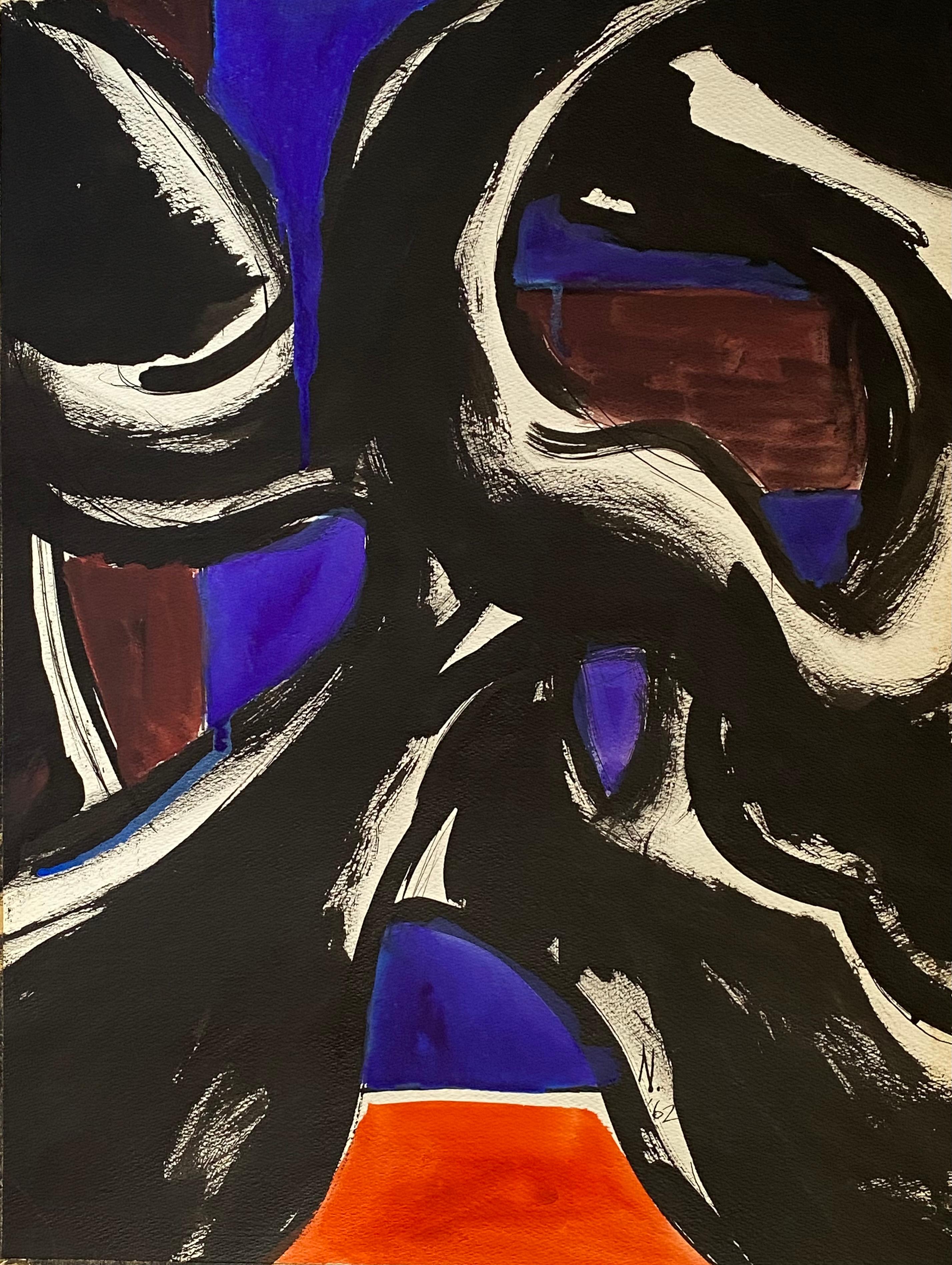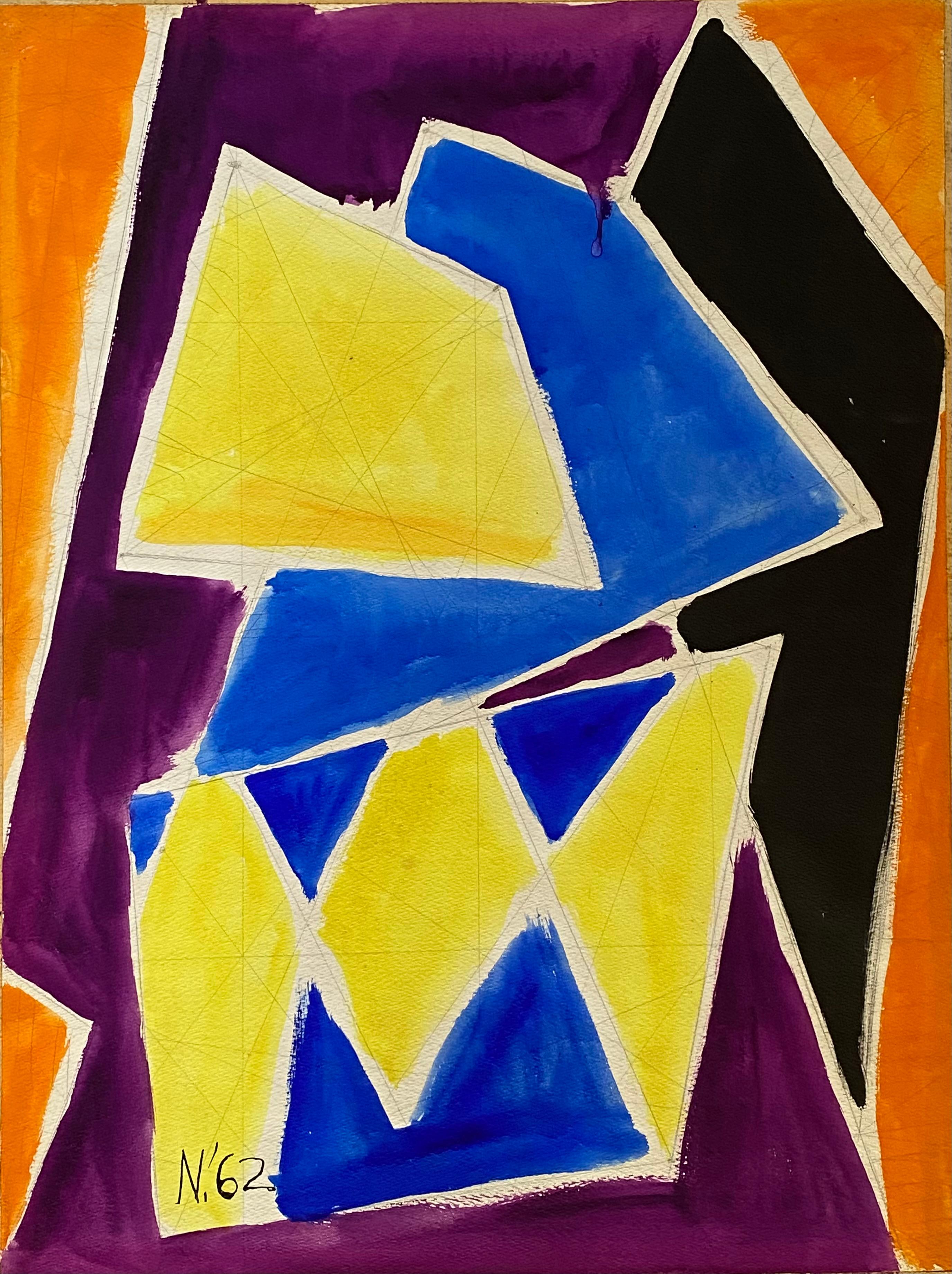Items Similar to Ave Maria by Erté
Want more images or videos?
Request additional images or videos from the seller
1 of 8
Erte - Romain de TirtoffAve Maria by Erté1928
1928
About the Item
Erté (Romain de Tirtoff)
1892-1990 Russian-French
Ave Maria
Signed "Erté" (center right)
Inscribed "N°1.349 / Victor Herbert Finale / Ave Maria / Décor / G.W.S. 1928" (en verso)
Gouache on paper
Designed for a performance in 1928,Ave Maria reflects the apex of Erté's expertise in set design. Erté's vision for the performance feels otherworldly, as he renders a host of angels within the display. Vibrant blue hues intermingle with the warm light of countless candles, imbuing the painting with a transcendent and ethereal air. Erté's sets did more than match the performances they were designed for; his creations elevated the shows to higher levels of emotional and artistic potency.
The captivating alliance between Erté and the vibrant performing arts scene of Paris transported audiences tonew heights throughout the early 20th century. Erté emerged as an unmatched and emblematic creative force whose visionary designs were imbued with an otherworldly appeal. His mesmerizing costume and set designs left an indelible imprint on operatic and theater productions of the period.
Russian-French visionary Romain de Tirtoff (1892-1990), popularly known as Erté, began his artistic journey in the culturally rich city of St. Petersburg, where he developed an early fondness for ballet and theatrical performances. He moved to Paris in 1912 to study architecture, and quickly found his creative niche in crafting fantastical costumes for the city's bustling nightlife. Erté's expertise, refined under the guidance of the famed Paul Poiret, captured the attention of Harper's Bazaar, marking the beginning of a significant partnership that spanned from 1915 to 1936. The artist also designed sets for notable cinematic masterpieces including Ben Hur and La Bohème, and created sets and costumes for cabarets, operas and other performances at the Folies-Bergères, Bal Tabarin, the Théâtre du Bataclan and Le Casino de Paris. Erté was a trailblazer whose colorful creations shaped the groundbreaking Art Deco era more than any other, leaving an indelible mark on the history of art and design. His artworks reside in prestigious museum collections worldwide, including the Metropolitan Museum of Art in New York, the Victoria & Albert Museum in London and the Los Angeles County Museum of Art.
Painted 1928
Paper: 11" high x 15" wide
Frame: 16 7/8" high x 20 3/4" wide x 5/8" deep
Label affixed en verso translates to: "A large, highly stylized statue of the Virgin, all in silver adorned with diamonds, emerges from a pyramid of candles, these candles must be made of cardboard with electric bulbs imitating flames exactly. Below, around the candles, nuns, all dressed in long white robes, are kneeling; they sing while stretching their arms towards the Madonna. From the high crown of the Virgin comes an enormous blue veil with printed designs representing enormous white angels and clouds of different blue tones at the bottom. It is through this veil that we see the statue of the Madonna, the candles and the nuns; it requires very bright lighting behind the veil. The top of the Virgin's crown, which is not veiled by the blue veil, forms like a dome of diamonds. Behind the statue of the Virgin we see an aurora embroidered in diamonds and different shades of blue. This halo is embroidered on the plain black velvet background curtain. It is necessary that the statue of the Virgin is very well sculpted."
Provenance:
Private collection, Paris
M.S. Rau, New Orleans
Exhibitions:
M.S. Rau, New Orleans, Erté and the Era of Art Deco, October 14, 2023 - January 3, 2024
- Creator:Erte - Romain de Tirtoff (1892 - 1990, Russian)
- Creation Year:1928
- Dimensions:Height: 16.875 in (42.87 cm)Width: 20.75 in (52.71 cm)Depth: 0.625 in (1.59 cm)
- Medium:
- Movement & Style:
- Period:
- Condition:
- Gallery Location:New Orleans, LA
- Reference Number:
Erte - Romain de Tirtoff
Erté, Romain de Tirtoff, (1892–1990) was a Russian-born French artist and designer who is equally famous for his elegant fashion designs and his artwork, both of which capture the art deco period in which he worked. Diversely talented, Erté was born in Saint Petersburg to a distinguished family with roots tracing back to 1548. After moving to Paris, he secured his first substantial contract with Harper's Bazaar magazine, and thus launched an illustrious career that included designing costumes and stage sets. Between 1915–1937, Erte designed over 200 covers for Harper's Bazaar, and his illustrations would also appear in such publications as Illustrated London News, Cosmopolitan, Ladies' Home Journal, and Vogue. Erté flourished and was renowned in an array of fields, including fashion, jewelry, graphic arts, costume and set design for film, theater, and opera, and interior decor.
After designing apparel for the French dancer Gaby Deslys, Erté went on to design costumes, program designs, and sets which were featured in the Ziegfeld Follies of 1923, many productions of the Folies Bergère, and George White's Scandals. On Broadway, the celebrated French chanteuse Irène Bordoni wore Erté's designs. His delicate figures and sophisticated, glamorous designs are instantly recognizable, and his ideas and art still influence fashion into the 21st century.
About the Seller
5.0
Vetted Seller
These experienced sellers undergo a comprehensive evaluation by our team of in-house experts.
Established in 1912
1stDibs seller since 2013
15 sales on 1stDibs
Typical response time: 5 hours
- ShippingRetrieving quote...Ships From: New Orleans, LA
- Return PolicyThis item cannot be returned.
More From This SellerView All
- Acte I, La Grande Duchesse By ErtéBy Erte - Romain de TirtoffLocated in New Orleans, LAErté (Romain de Tirtoff) 1892-1990 | Russian-French Acte I, La Grande Duchesse Signed “Erté” (lower right) Inscribed "La Traviata / 1er acte / Entrée des invités / Composition orig...Category
20th Century Art Deco Abstract Drawings and Watercolors
MaterialsPaper, Gouache
- Musiciens Sur Fond Multicolore By Marc ChagallBy Marc ChagallLocated in New Orleans, LAMarc Chagall 1887-1985 Russian Musiciens sur fond multicolore (Musicians on a multicolored background) Signed 'Chag' (on the sleeve of the right figure); stamped with the signature 'Marc Chagall' (lower right) Tempera, gouache, colored ink and India ink and pastel on paper “The fact that I made use of cows, milkmaids, roosters and provincial Russian architecture as my source forms is because they are part of the environment from which I spring and which undoubtedly left the deepest impression on my visual memory of the experiences I have." - Marc Chagall Marc Chagall’s 1981...Category
20th Century Post-Impressionist Figurative Drawings and Watercolors
MaterialsPaper, Pastel, Ink, India Ink, Tempera, Gouache
- Mer De Sable By Alexander CalderBy Alexander CalderLocated in New Orleans, LAAlexander Calder 1898 – 1976 American Mer de sable (Sea of sand) Gouache and ink on paper Signed and dated with artist’s monogram “CA and ‘75” (lower right) This vibrant gouache ...Category
20th Century Post-Impressionist Abstract Drawings and Watercolors
MaterialsPaper, Ink, Gouache
- Guitare sur un guéridon by Pablo PicassoBy Pablo PicassoLocated in New Orleans, LAPablo Picasso 1881-1973 Spanish Guitare sur un guéridon (Guitar on a pedestal) Gouache on Western wove paper laid on board Signed “Picasso” (upper left) Picasso’s prolific career has been marked by many grand love affairs, both romantic, intellectual and creative. Beyond his lovers like Olga Khoklova and Dora Maar and his intellectual muses like Georges Braques and Gertrude Stein, Picasso’s greatest love and inspiration was perhaps a humble instrument: the guitar. Whether it be the Old Guitarist from his early blue period, his groundbreaking series of three-dimensional guitar sculptures from his nascent explorations in Cubism, or his Mandolin and Guitar composition’s grander explorations with color and biomorphic shapes, the guitar is an elusive calling card for modern art’s greatest genius. In Guitare sur un guéridon, Picasso intertwines his signature guitar and a bowl of fruit. These two elements are playfully brought together and skillfully anchored on the tabletop by a square positioned at the center of the composition. The result is a captivating and harmonious arrangement that showcases Picasso's artistic ingenuity in blending these everyday objects into a visually striking and cohesive composition. This rare gouache was created during the pivotal summer of 1920. During this time, Picasso lived in Juan-les-Pins, a small coastal resort town in the South of France away from the confines of the city and the fallout of World War I. With this newfound freedom, Picasso entered an exciting and innovative creative period and began to interrogate the connections between Neoclassicism and Cubism. Picasso created a series of gouache paintings characterized by their flat, geometric nature, sinuous contours and strikingly vivid colors. Though not a complete departure from his previous Cubist works, this series showcased the influence of the Surrealists, especially the biomorphic subconscious explorations of Joan Miró, upon Picasso’s oeuvre. While the breadth of his creativity grew, he returned back to a familiar motif — the guitar — with a renewed sense of vigor and excitement. Guitare sur un guéridon’s undulating lines and biomorphic appeal bring Picasso's preoccupation with the guitar into deeper focus. The sinuous lines of guitar mirror...Category
20th Century Post-Impressionist Abstract Drawings and Watercolors
MaterialsPaper, Gouache, Board
- La Dionée Dite Gobe-Mouches By ErtéBy Erte - Romain de TirtoffLocated in New Orleans, LAErté (Romain de Tirtoff) 1892-1990 Russian-French La dionée dite Gobe-mouches(Venus Flytrap) Signed "Erté" (lower right) Inscribed ---- (en verso) Gouache on paper Daring and mysterious, this original gouache from the creative mind of Erté features the sinuous figure of a woman wearing a unique ebony and sanguine body suit with a dramatic wing-like cape. Entitled La dionée dite Gobe-mouches or Venus Flytrap, this work embodies the Art Deco glamour and tongue-in-cheek artistry for which the artist's designs are so beloved. Inspired by the famed volume of poems from iconic French writer Charles Baudelaire, this ensemble showcases Erté's sartorial interpretation of La Vampire from Baudelaire's Les Fleurs du mal. This elegant composition exudes the quintessential opulence and drama that only Erté, the oft-called "Father of Art Deco," could achieve. La dionée dite Gobe-mouches showcases the breadth of Erté's creativity and his design expertise. First published in 1857, Baudelaire's Les Fleurs du mal was controversial for its suggestive content and themes of decadence and eroticism. The volume provided a wealth of inspiration for Erté and he drew from several specific poems to create original fashion sketches...Category
20th Century Art Deco Figurative Drawings and Watercolors
MaterialsPaper, Gouache
- L'Aurore boréale by ErtéBy Erte - Romain de TirtoffLocated in New Orleans, LAErté (Romain de Tirtoff) 1892-1990 Russian-French L'Aurore boréale(The Aurora Borealis) Signed "Erté" (lower right) Inscribed ---- (en verso) Gouache on paper In this colorful gouache, Erté draws an enticing and unique fashion design on his model's elegantly elongated figure. Crowned by an elaborate headdress, the woman wears a daring gauzy caftan that drapes dangerously low, celebrating her nude form. EntitledL'Aurore Boréale" or The Aurora Borealis, this work embodies the Art Deco glamour for which the artist's designs are so beloved. This ensemble was inspired by Les Fleurs du mal, the famed volume of poems from iconic French writer Charles Baudelaire. As the name suggests, this creative design links the celebrated "fleur" orchids with one of nature's other great marvels, the Aurora Borealis. This refined piece of art radiates the essential luxury and theatricality that could only be accomplished by Erté, oft referred to as the "Father of Art Deco." First published in 1857, Baudelaire's Les Fleurs du mal was controversial for its suggestive content and themes of decadence and eroticism. The volume provided a wealth of inspiration for Erté and he drew from several themes to create original fashion sketches...Category
20th Century Art Deco Figurative Drawings and Watercolors
MaterialsPaper, Gouache
You May Also Like
- Marie Palmer-Smith - 1930s British Art Deco gouache designLocated in London, GBMARIE PALMER-SMITH (1899-1997) Silver Cloud Bears artist’s studio stamp on the reverse Gouache on silver paper Unframed in mount 15 by 22.5 cm., 6 by 8 ¾ in. (mount size 29.5 by 3...Category
1930s Art Deco Abstract Drawings and Watercolors
MaterialsGouache
- Colorful Marketplace, Modernist Abstract Figurative Shakespeare festivalBy Doris Ann WarnerLocated in Soquel, CABright and colorful modernist market scene with abstracted figures on heavy bond paper by Doris Ann Warner (American, 1925-2010). Signed "WARNER" in the lower right corner. Presented in a new double mat of light blue and antique buff...Category
Late 20th Century Cubist Figurative Drawings and Watercolors
MaterialsPaper, Watercolor, Gouache
- “Abstract Face”By Lloyd Raymond NeyLocated in Southampton, NYHere for your consideration is a well executed original watercolor and gouache abstract on archival paper by the New Hope, Pennsylvania artist, Lloyd Ney. Ney was considered to be a non-objective artist. Appears to be an abstract face. Signed and dated lower center 1962. Strong, vibrant colors. Condition is very good. Presently unframed. The artwork was mounted by the artist onto Nelson show card board. Provenance: A Pennsylvania estate. Lloyd Raymond Ney was an American non-objective artist. Known as Bill Ney, he was born in Friedenburg, Pennsylvania March 8th, 1893, the son of William W. Ney and Sadie Maidenford. He studied at the Pennsylvania Museum School of Industrial Art and at the Pennsylvania Academy of Fine Arts in Philadelphia. In 1918 he won a Cresson Fellowship to study in Europe. In the 1920's Ney traveled to France where he studied and painted in Paris among the vital European modernist community. He lived at the Hotel de Versailles, 60 Boulevard Montparnasse. During this period Ney created his major work, "The Drinkers," Later, the artist wrote extensively about the process of developing this work and the transforming experience of integrating the Modernist ideal he had witnessed in Paris. After returning to the United States, Ney settled in New Hope, PA, an established art community between New York and Philadelphia. Unlike more New Hope artists who followed impressionism in the early 20th century, Ney embraced a more expressive contemporary style including non-objective works. He was among a group of artist known as the "Independents," who challenged the traditional subject matter of regional artists. They formed a new exhibition group. Ney was part of the "New Hope Modernist...Category
1960s Post-Modern Abstract Drawings and Watercolors
MaterialsWatercolor, Archival Paper, Gouache
- “Abstract in Blue, Black and Green”By Lloyd Raymond NeyLocated in Southampton, NYOriginal watercolor, gouache and ink abstract on archival paper by the well known New Hope, Pennsylvania artist, Lloyd Raymond Ney. Signed and dated lower left, 1961. Condition is very good. Strong, vibrant colors. Presently unframed. The artwork was mounted by the artist onto Nelson show card board. Provenance: A Pennsylvania estate.. Lloyd Raymond Ney was an American non-objective artist. Known as Bill Ney, he was born in Friedenburg, Pennsylvania March 8th, 1893, the son of William W. Ney and Sadie Maidenford. He studied at the Pennsylvania Museum School of Industrial Art and at the Pennsylvania Academy of Fine Arts in Philadelphia. In 1918 he won a Cresson Fellowship to study in Europe. In the 1920's Ney traveled to France where he studied and painted in Paris among the vital European modernist community. He lived at the Hotel de Versailles, 60 Boulevard Montparnasse. During this period Ney created his major work, "The Drinkers," Later, the artist wrote extensively about the process of developing this work and the transforming experience of integrating the Modernist ideal he had witnessed in Paris. After returning to the United States, Ney settled in New Hope, PA, an established art community between New York and Philadelphia. Unlike more New Hope artists who followed impressionism in the early 20th century, Ney embraced a more expressive contemporary style including non-objective works. He was among a group of artist known as the "Independents," who challenged the traditional subject matter of regional artists. They formed a new exhibition group. Ney was part of the "New Hope Modernist...Category
1960s Post-Modern Abstract Drawings and Watercolors
MaterialsWatercolor, Archival Paper, Ink, Gouache
- “Untitled Abstract”By Lloyd Raymond NeyLocated in Southampton, NYOriginal watercolor, gouache and graphite abstract on archival paper by the well known non-objective artist., Lloyd Raymond Ney.. Signed and dated lower left, 1962. Condition is very good. Strong, vibrant colors. The artwork was mounted by the artist onto Nelson show card board. Presently unframed. Provenance: A Pennsylvania estate. Lloyd Raymond Ney was an American non-objective artist. Known as Bill Ney, he was born in Friedenburg, Pennsylvania March 8th, 1893, the son of William W. Ney and Sadie Maidenford. He studied at the Pennsylvania Museum School of Industrial Art and at the Pennsylvania Academy of Fine Arts in Philadelphia. In 1918 he won a Cresson Fellowship to study in Europe. In the 1920's Ney traveled to France where he studied and painted in Paris among the vital European modernist community. He lived at the Hotel de Versailles, 60 Boulevard Montparnasse. During this period Ney created his major work, "The Drinkers," Later, the artist wrote extensively about the process of developing this work and the transforming experience of integrating the Modernist ideal he had witnessed in Paris. After returning to the United States, Ney settled in New Hope, PA, an established art community between New York and Philadelphia. Unlike more New Hope artists who followed impressionism in the early 20th century, Ney embraced a more expressive contemporary style including non-objective works. He was among a group of artist known as the "Independents," who challenged the traditional subject matter of regional artists. They formed a new exhibition group. Ney was part of the "New Hope Modernist...Category
1960s Post-Modern Abstract Drawings and Watercolors
MaterialsWatercolor, Archival Paper, Graphite, Gouache
- UntitledBy Dannielle TegederLocated in New York, NYGouache, colored pencil, graphite, and pastel on paper Signed and dated in black ink, verso This artwork is offered by ClampArt, located in New York City. Born in Peekskill, New Yo...Category
2010s Abstract Geometric Abstract Drawings and Watercolors
MaterialsPaper, Pastel, Gouache, Color Pencil, Graphite
Recently Viewed
View AllRead More
Wear Louis Comfort Tiffany’s Genius on Your Finger with This Vivid Ring
In his jewelry making, the designer rarely used diamonds — this rare example has two.
You Won’t Find a More Handsome Stopwatch Than This 1890s Pocket Chronograph
A Grand Complication from the golden era of pocket watches, the Marius Lecoultre pocket watch does everything but uncork your wine.






